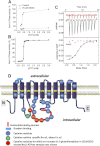S-glutathionylation of the Na,K-ATPase catalytic α subunit is a determinant of the enzyme redox sensitivity
- PMID: 22798075
- PMCID: PMC3442550
- DOI: 10.1074/jbc.M112.391094
S-glutathionylation of the Na,K-ATPase catalytic α subunit is a determinant of the enzyme redox sensitivity
Abstract
Na,K-ATPase is highly sensitive to changes in the redox state, and yet the mechanisms of its redox sensitivity remain unclear. We have explored the possible involvement of S-glutathionylation of the catalytic α subunit in redox-induced responses. For the first time, the presence of S-glutathionylated cysteine residues was shown in the α subunit in duck salt glands, rabbit kidneys, and rat myocardium. Exposure of the Na,K-ATPase to oxidized glutathione (GSSG) resulted in an increase in the number of S-glutathionylated cysteine residues. Increase in S-glutathionylation was associated with dose- and time-dependent suppression of the enzyme function up to its complete inhibition. The enzyme inhibition concurred with S-glutathionylation of the Cys-454, -458, -459, and -244. Upon binding of glutathione to these cysteines, the enzyme was unable to interact with adenine nucleotides. Inhibition of the Na,K-ATPase by GSSG did not occur in the presence of ATP at concentrations above 0.5 mm. Deglutathionylation of the α subunit catalyzed by glutaredoxin or dithiothreitol resulted in restoration of the Na,K-ATPase activity. Oxidation of regulatory cysteines made them inaccessible for glutathionylation but had no profound effect on the enzyme activity. Regulatory S-glutathionylation of the α subunit was induced in rat myocardium in response to hypoxia and was associated with oxidative stress and ATP depletion. S-Glutathionylation was followed by suppression of the Na,K-ATPase activity. The rat α2 isoform was more sensitive to GSSG than the α1 isoform. Our findings imply that regulatory S-glutathionylation of the catalytic subunit plays a key role in the redox-induced regulation of Na,K-ATPase activity.
Figures







Similar articles
-
Cross talk between S-nitrosylation and S-glutathionylation in control of the Na,K-ATPase regulation in hypoxic heart.Am J Physiol Heart Circ Physiol. 2012 Dec 1;303(11):H1332-43. doi: 10.1152/ajpheart.00145.2012. Epub 2012 Sep 14. Am J Physiol Heart Circ Physiol. 2012. PMID: 22982781
-
Glutathionylation of Na,K-ATPase Alpha-Subunit Alters Enzyme Conformation and Sensitivity to Trypsinolysis.Biochemistry (Mosc). 2018 Aug;83(8):969-981. doi: 10.1134/S0006297918080084. Biochemistry (Mosc). 2018. PMID: 30208833
-
Effect of Reduction of Redox Modifications of Cys-Residues in the Na,K-ATPase α1-Subunit on Its Activity.Biomolecules. 2017 Feb 21;7(1):18. doi: 10.3390/biom7010018. Biomolecules. 2017. PMID: 28230807 Free PMC article.
-
"Oxygen Sensing" by Na,K-ATPase: These Miraculous Thiols.Front Physiol. 2016 Aug 2;7:314. doi: 10.3389/fphys.2016.00314. eCollection 2016. Front Physiol. 2016. PMID: 27531981 Free PMC article. Review.
-
Oxidative regulation of the Na(+)-K(+) pump in the cardiovascular system.Free Radic Biol Med. 2012 Dec 15;53(12):2263-8. doi: 10.1016/j.freeradbiomed.2012.10.539. Epub 2012 Oct 17. Free Radic Biol Med. 2012. PMID: 23085513 Review.
Cited by
-
Identification of cisplatin-binding sites on the large cytoplasmic loop of the Na+/K+-ATPase.J Enzyme Inhib Med Chem. 2018 Dec;33(1):701-706. doi: 10.1080/14756366.2018.1445735. J Enzyme Inhib Med Chem. 2018. PMID: 29577756 Free PMC article.
-
Oxidative Stress in the Regulation of Autosis-Related Proteins.Antioxidants (Basel). 2025 Aug 4;14(8):958. doi: 10.3390/antiox14080958. Antioxidants (Basel). 2025. PMID: 40867854 Free PMC article. Review.
-
Carbonylation Modification Regulates Na/K-ATPase Signaling and Salt Sensitivity: A Review and a Hypothesis.Front Physiol. 2016 Jun 28;7:256. doi: 10.3389/fphys.2016.00256. eCollection 2016. Front Physiol. 2016. PMID: 27445847 Free PMC article. Review.
-
Mitochondrial respiratory chain inhibition and Na+K+ATPase dysfunction are determinant factors modulating the toxicity of nickel in the brain of indian catfish Clarias batrachus L.Interdiscip Toxicol. 2018 Dec;11(4):306-315. doi: 10.2478/intox-2018-0030. Epub 2019 Oct 18. Interdiscip Toxicol. 2018. PMID: 31762682 Free PMC article.
-
Glutathione-related substances maintain cardiomyocyte contractile function in hypoxic conditions.Sci Rep. 2019 Mar 19;9(1):4872. doi: 10.1038/s41598-019-41266-2. Sci Rep. 2019. PMID: 30890744 Free PMC article.
References
-
- Blanco G., Mercer R. W. (1998) Isozymes of the Na-K-ATPase. Heterogeneity in structure, diversity in function. Am. J. Physiol. 275, F633–F650 - PubMed
-
- Glitsch H. G. (2001) Electrophysiology of the sodium-potassium-ATPase in cardiac cells. Physiol. Rev. 81, 1791–1826 - PubMed
-
- Geering K. (2008) Functional roles of Na,K-ATPase subunits. Curr. Opin. Nephrol. Hypertens. 17, 526–532 - PubMed
-
- Kaplan J. H. (2002) Biochemistry of Na,K-ATPase. Annu. Rev. Biochem. 71, 511–535 - PubMed
-
- Bogdanova A., Petrushanko I., Boldyrev A., Gassmann M. (2006) Oxygen- and redox-induced regulation of the Na/K-ATPase. Curr. Enzyme Inhibition 2, 37–59
Publication types
MeSH terms
Substances
LinkOut - more resources
Full Text Sources
Other Literature Sources

